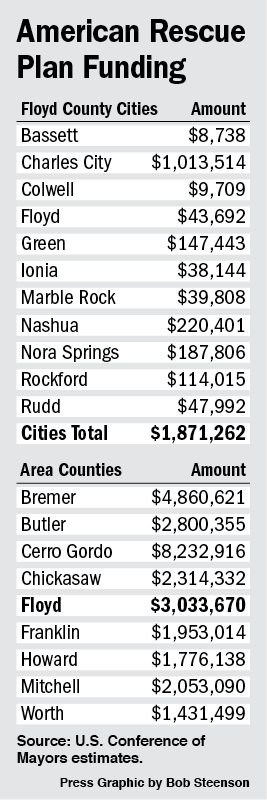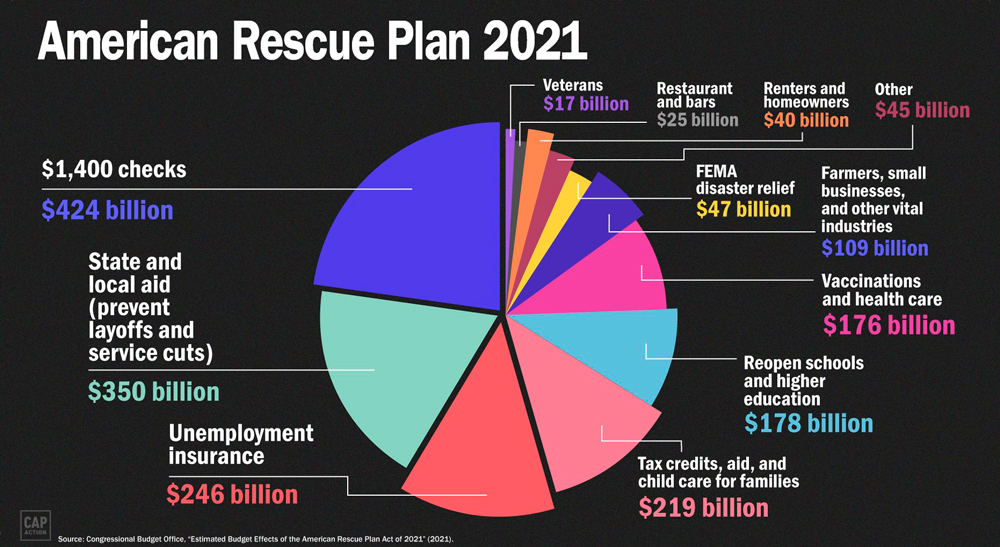Millions of dollars coming to Floyd County and its cities through COVID funds
By Bob Steenson, bsteenson@charlescitypress.com
The state of Iowa and its cities and counties are expected to receive a total of almost $2.7 billion in funding through the American Rescue Plan passed earlier this month.
 Of that, almost $4.9 million is expected to come to Floyd County and cities in the county, including over a million dollars to Charles City.
Of that, almost $4.9 million is expected to come to Floyd County and cities in the county, including over a million dollars to Charles City.
In addition, $774.5 million will be divided among Iowa school districts.
And, of course, that’s in addition to the almost $4 billion that individual Iowans will receive in $1,400 stimulus direct deposits or checks.
The American Rescue Plan Act of 2021 includes direct funding for cities, counties and states from the U.S. Treasury as well as money that will flow through other programs and departments. The dollar amounts are decided by a combination of population and other factors, such as a state’s unemployment rate.
The U.S. Conference of Mayors, using the formulas included in the Rescue Plan, estimated the amount to be received by every state, city and county, including the District of Columbus.
According to those estimates, Floyd County will receive $3,033,670, and Charles City will receive $1,013,415.
Charles City Mayor Dean Andrews said Monday that the City Council had not discussed the money yet, but possible uses he thought of included the new Charley Western Trail Bridge and efforts to create a city fiber-to-the premises broadband system.
The Floyd County Board of Supervisors chatted about the potential county money when asked about it after a Monday morning workshop meeting.
County Auditor Gloria Carr said they were waiting for more information.
“We don’t know what we’re going to do. We’re waiting for the Department of Treasury to tell us how we can spend it,” she said.
Carr said she had heard a similar $3.034 million figure, “but that’s not even concrete. That’s subject to change.”
She said she would like the board to be able to use some of the money on the law enforcement center and courthouse update project, but she isn’t sure if that will fit the guidelines.
“Loss of revenue is included” in the COVID-19-caused items that can be covered under the Rescue Plan, Carr said, referring to expected interest revenue the county had been planning to use from investing bond money before it was needed, and that was significantly less than expected because interest rates fell with the coronavirus.
“I don’t know if we can claim some of that or not,” Carr said.
Supervisor Linda Tjaden said, “With this opportunity, we just need to make sure we’re looking at the county as a whole.”
In addition to Charles City’s million dollars, other cities in the county will receive amounts varying from $9,709 for Colwell to $220,401 for Nashua, the next highest amount after Charles City.
According to the Rescue Plan, the funds can be used for the following purposes:
- To respond to the coronavirus health impacts or economic impacts including assistance to households, small businesses, nonprofits, and impacted industries including hospitality, travel, and tourism.
- To provide premium pay for essential workers up to $13 an hour with an annual cap of $25,000.
- To cover for lost revenue in providing services.
- To make investments in water, sewer or broadband infrastructure.
The plan has been controversial in that funds cannot be used to cover lost revenues if the loses were due to a tax cut, and because unemployment rates are one of the factors in allocating the funds, according to reporting by The Associated Press.
The unemployment part of the formula ends up allocating extra money to larger, mostly Democratic-run states with higher unemployment rates, while rural Midwestern and Southern states that tend to have Republican governors and better jobless numbers benefit less.
Gov. Kim Reynolds, a Republican, has said the funding formula “punishes states that took a measured approach to the pandemic and entered the crisis with healthy state budgets and strong economies.”
The White House defended President Joe Biden’s distribution plan, saying it targets money to areas where it will have the biggest impact.
Funds also cannot be used to cover public pension shortfalls.
States, including the District of Columbia, will receive a total of $219.8 billion. Cities and counties will receive a total of $130.2 billion. Out of that total, $65.1 billion will go to counties. The funds will be distributed directly from the Treasury.
Another $45.57 billion will go to cities over 50,000 in population in a formula that considers the amount of Community Development Block Grant (CDBG) funding they receive. These funds will be distributed directly by the Treasury within 60 days.
For cities under 50,000, funds will be allocated according to population. The Treasury will distribute these funds to the states within 60 days. The states then have 30 additional days to distribute the funds to the smaller cities.
Counties and cities have until Dec. 31, 2024, to spend the money. Half the funds for counties and all cities will be distributed initially. The remaining half will be distributed a year after the first distribution.
The direct funding also includes $10 billion for the Coronavirus Capital Projects Fund, to be sent to the states to be focused apparently on broadband infrastructure.
Other funding includes $50 billion for the Federal Emergency Management Agency. By defining the coronavirus as eligible for disaster funding, local governments can be reimbursed for COVID-related expenses such as purchasing protective equipment, covering the costs of vaccine distribution and sanitizing schools, municipal offices, transit properties, and courthouses.
Similar funding was also included in the previous Coronavirus Aid, Relief, and Economic Security Act, passed under former President Donald Trump.
The Rescue Plan also allocates $25 billion for rental and utility assistance, $10 billion for mortgage assistance, and $4.75 billion for homeless assistance.
— The Associated Press contributed to this report.










Social Share